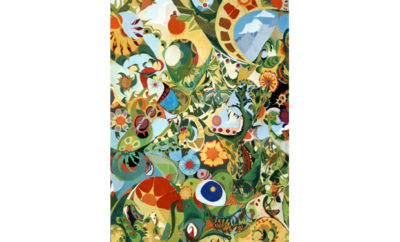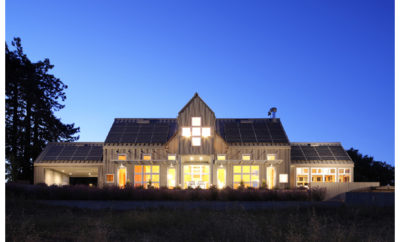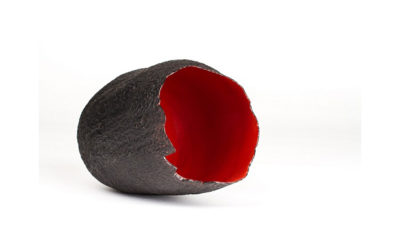
Feature
The Fabulous Bakker Boys
They are father and son. They are designers. They work within walking distance of each other in Amsterdam. We visit the studios of Gijs and Aldo Bakker and find similarities, but also differences, in the ways they work, think, and create.

Father and son designers Gijs (right) and Aldo Bakker.
NO ONE HAS SEEN DUTCH DESIGN EVOLVE as closely as Gijs Bakker. Indeed, no one has had a hand in that evolution as much as Gijs Bakker. The seventy-three-year-old Dutchman is a silversmith and jewelry maker, a creator of furniture and of lighting; he was a co-founder of the ever sassy Droog Design in 1993 and, in 1996, of the jewelry brand now called “chp…?” He also taught for many years. And he still designs. He’s busy. On a sunny morning he opens the front door of his studio on the Keizersgracht in Amsterdam with a welcome question: “Coffee?”
“If I explain to strangers what I do, I never start by mentioning jewelry,” he tells me. “I first say that I make furniture, then lighting. And only then jewelry,” he says. “Why? The traditional world of jewelry is a strange world, inhabited by beautiful women with diamonds tucked in between their breasts. I don’t want to have anything to do with that.” His view on this is longstanding. In 1967 he mounted with his late wife, Emmy Van Leersum, a “catwalk show” that presented jewelry as an art form; last year he was able to reprise that at the Stedelijk Museum. “Carrying out our vision is a continuous struggle, even today.” His weapons in this struggle? The objects he continues to design and show to the world through galleries (including a recent exhibition at New York’s Atelier Courbet) and chp…?.
Between 1993 and 2003 I spent a lot of energy—and an insane amount of pleasure and enthusiasm—on Droog Design. Chp…? was the little sister, but at the moment I am putting all of my energy in it. Now there is an exhibition that in the next couple of years will travel to China, Mexico, and possibly New York.”

Aldo’s AlinetoB (2014) series of pitchers in pastel shades was the result of a commission by venerable French porcelain manufacturer Sèvres–Cité de la Céramique.
Bakker’s jewelry, furniture, and lighting can also be found in several international museums, such as the Museum of Fine Arts in Houston and the State Hermitage Museum in Russia. “I’m so happy that my work has ended up in art museums and not in craft museums,” he says. “Let it be clear—I find that quite a victory. I owe a lot to the museum directors here in the Netherlands, but especially to the American expert Helen Drutt, who recently donated her entire collection to the Museum of Fine Arts, Houston. Ever since we met in 1974, Helen has been my biggest fan, supporter, and buyer. Always, even now when she no longer has her own gallery in Philadelphia, she can always pick out my best pieces. She understands me completely.”
Bakker’s recent jewelry designs include the 3 Point 7 necklace—shown by the Brussels-based Caroline Van Hoek Gallery at Design Miami/Basel this past summer. “This came from a very simple idea—people no longer know what materials are, what they mean and how they feel,” he says. “I wanted to make a chain link necklace in which every link was the exact same weight—in this case 3.7 grams [about 0.13 ounce]. The smallest link in the chain is gold, and I used an array of other materials from silver to titanium and Plexiglas to jade for the other links. And of course they had to be connected to each other.” He points out that the materials and their dimensions determine the result (gold, for example, can be soldered, but a material such as jade can only be carved); such restrictions encourage creativity, he says.

Gijs’s 3 Point 7 necklace (2014) comprises links of the same weight in various materials, including jade, aluminum, Plexiglass, titanium, tantalum, stainless steel, silver, and gold.
“I’m a really conceptual thinker. I need to have a concept and an idea first, and from there I define the course of the rules. All the rules have to be resolved. It has nothing to do with beauty, elegance, or commercial value. They’re purely substantive requirements. But beauty and elegance may be the result. I think the chain necklace is gorgeous and it feels great in your hands.”
Gijs knows the boundaries and interactions between art and design all too well. “In 1980 I created an exhibition about Dutch design. At the presentation I was asked whether I saw design as an art form. I replied: ‘Yes. Design is an art form, in the same way that architecture is.’ The audience pro- tested heavily. ‘Mister Bakker, you’re talking nonsense,’ the traditional museum directors said. But I stick to my point: if design is visionary and if it moves things forward, then you can certainly call it an art form. If it merely reproduces, we can call it craft or trade. Or industrial design.”
In 2013 he devised Plastic Soup, a bracelet made from straws, on which pure gold or silver is melted. “Of course this is a direct comment on the plastic waste we constantly produce as a society,” he says. “I’m a very curious person by nature. From time to time I’m invited to speak about history, but I’m actually more interested in the latest developments, both technically and culturally. That stimulates me. The materials and techniques have evolved so much. The technique of directly 3-D-printing gold is just around the corner—gold will then melt while it is being built. It’s up to us designers to get the most out of that technology instead of making silly jewelry—the market is full of that already. No, let’s not do that.”

In spring 2015 Gijs’s jewelry brand debuted chp 75 Flower, designed by Studio Minale- Maeda. It is an encrypted downloadable file from which an orchid is 3-D printed.
Indeed, at the latest international Salone del Mobile in Milan Bakker launched the chp…? “jewelry computer file.” Customers buy a file, not a jewel, which they can then set up to 3-D print. An algorithm determines the final shape. “There are so many possibilities! Our brain doesn’t stand still. We are at the eve of an evolution that we can’t even see yet. We are definitely at a turning point in history.”
In whatever way they materialize, we are surrounded by objects; but for Bakker, “things have a soul. And the items that don’t have one, I don’t want around me. To me that soul means having a certain substantial meaning, a background. I hardly need anything anymore. I would rather have less than more, but if I get new socks for my birthday and I like them, I’m happy. But I’m not just going to buy the latest decorative product. No. The last thing I bought is an amazing carafe by my son Aldo. I think that boy is so good. He redefines what beauty means to me. But there is also a concept behind it. You should ask him about it.”
WITH THAT CHALLENGE I LEAVE THE KEIZERSGRACHT. After less than half an hour walking I find myself at Aldo Bakker’s studio in a residential street. In front of his door neighbors are playing soccer; next to them furniture makers are varnishing, smoking, and drinking coffee. “Shall we also sit on the sidewalk?” Aldo asks. And indirectly he immediately proves his father right, even though he doesn’t utter the word “beauty” throughout our conversation. “In Dutch it is easy for me to explain what I do—I simply use the word vormgever [literally form-giver]—because I give shape. Like an artist who paints is a painter, and someone who illustrates is an illustrator. For me it starts and ends with form: that’s the common thread. If you translate vormgever into English it becomes designer, and that’s harder for me to relate to. Because I think my work happens in between several disciplines. There is a part of design and a part of art that I appreciate, but I also appreciate music and architecture. I know what I am doing, but the moment I have to add myself to the market, I’m confronted with certain labels that don’t seem to fit.”

The 2015 Urushi table and stool are part of Aldo’s series of furniture employing urushi, a labor-intensive Japanese lacquer technique.
Just like his father, Aldo works for both brands and galleries. He works with wood, metal, silver, porcelain, and urushi lacquer. His stainless steel collection for Georg Jensen includes two pitchers, a salt cellar, and a sugar bowl; he has also recently designed a series of interior accessories and tableware for the Danish brand Karakter, as well as a porcelain table line for Lyngby. He has exhibited with such galleries as Vivid (Rotterdam), Sofie Lachaert and Luc d’Hanis (Belgium), Maria Wettergren (Paris), Atelier Courbet (New York), and more recently with Pearl Lam (China). In September he is showing a new pouring vessel at Galerie MAM as part of Vienna Design Week (which actually runs from September 25 to October 4). “I haven’t counted them yet, but I must have already re- leased about thirty pitchers,” he says.
It’s a project that combines new technologies with traditional methods. “The Vienna pouring vessel will be a combination of traditional galvanization and 3-D printing. Both are ‘growth processes’ but lead to very different possibilities. The pot, handle, and lid are each made from different materials. It’s definitely a piece that belongs in a gallery.”
In the coming year, he is also working on a project for Pearl Lam that evolved after he visited a number of Chinese craftsmen’s workshops. Also for next year, he is preparing a book and a major retrospective of his work at CID (Centre d’Innovation et de Design) at GrandHornu in Belgium.

Aldo is best known for designing vessels with a distinctly organic character, such as the porcelain Jug + Cup (2011).
Aldo sees his way of working as mostly instinctive. “The work sort of creates itself. I can’t and don’t want to influence it too much myself. It’s this modus operandi that distinguishes me from my colleagues the most. I look around a lot and collect images in my head. And those images present themselves at a certain moment—they decide when they are ready for a critical view. I usually walk around with an image in my head for a long time while trying to translate it. Only at a relatively late stage do I make a sketch to see if it could become something. There is a great advantage to keeping images in my head. In there, nothing’s determined yet. It’s flexible. It’s unreal. When I’m ready to draw a sketch, I often realize that what seemed finished and perfect in my head is actually far from it on paper. It’s crazy to find out that I can fool myself so well. That’s when reason comes into play. Then I have to finish the puzzle. I will know if it’s a good design when I have grasped the logistics of it. Only when everything is correct does the object leave the studio. And not any sooner.”
Like his father, Aldo has ideas about the boundary between art and design. “Most of my work ends up with collectors and in museums. Some objects are very legible and immediately useful. But more often the function is not directly visible. In those cases you gradually find out how to handle the thing—and this may differ from one person to another.” For example, at the 2014 Design Miami/Basel, Galerie Vivid showed (among other pieces) a somewhat amorphous (and enigmatic) metal sculptural piece. Aldo says it “manifests itself entirely as itself, but we did give it the size of a side table. I think it’s essential that an object has character—that’s paramount to me. But if I can also give it a functional use—making it possible and desirable to interact with it—that’s fantastic. In other words, I love making something that is perceived valuable as art, but that also possesses the functional properties of design.

In 2014 Aldo was commissioned by Georg Jensen to design a suite of objects—a salt cellar, sugar bowl, and two pitchers—produced in mirror-polished stainless steel.
Although he never completed his own design education, Aldo has taught since 2002 at the Design Academy Eindhoven. “At a young age I was able to see a lot all over the world with my parents. At the time I didn’t always like it, though in retrospect it was great. When I was sixteen, my dad took me to an expo with glasswork from Leerdam. It was love at first sight. Sparks flew. The shapes, the colors, the materials— I thought it was all wonderful. I immediately started drawing; I saw hundreds of possibilities. That eventually resulted in my first glass champagne goblet. I felt in my entire being that it was right, but I couldn’t explain why. It was the first time that I experienced something like that, and that experience is still the benchmark. It’s a bit like being in love. Something very nice happens to you, but it’s also confusing and hard to interpret. And then, of course, you have to do something with it.”












